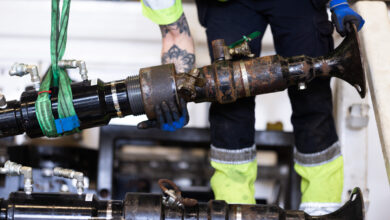Simplified model clarifies connection between MPD well control equipment, safety barriers
By Katie Mazerov, contributing editor
Managed pressure drilling (MPD) systems are increasingly being used in formations with restricted operational pressure windows, but a lack of understanding of the interaction between MPD well control equipment and the primary well safety barrier presents an increased risk of incidents, an engineering expert contends. “Our experience is that the drilling industry is struggling when it comes to understanding the primary well control envelope for MPD in general,” Arne Handal, senior engineer and product manager for Det Norske Veritas (DNV), said at the 2013 IADC/SPE Managed Pressure Drilling & Underbalanced Operations Conference & Exhibition, 17-18 April in San Antonio.
“For MPD operations, we have poor standards, and the definitions often vary or are inconsistent, meaning people think differently about these systems,” Mr Handal said. He clarified those definitions by comparing conventional drilling practices with MPD and introducing a simplified, closed-loop MPD control system model.
“To understand MPD, we need to start with a basic explanation of the conventional drilling pressure control system, where primary well control during normal drilling operations is achieved by maintaining sufficient mud weight to keep the hydrostatic pressure in the well in overbalance,” Mr Handal said. The primary well barrier, in this case, is provided by the mud column in the well. “To avoid degradation of the primary well barrier, the equivalent circulating density (ECD) should not unintentionally exceed the exposed formation fracture gradient.”
Impact on primary barrier
“When it comes to well control in MPD, the principle is the same: We need to keep the well in overbalance,” he continued. “But when we use MPD, we can actually change the pressure in the well during the operation.” In a typical MPD operation, primary well control uses active bottomhole pressures to keep the hydraulic well pressure in overbalance. The primary well barrier is the same as for conventional drilling only if the mud is designed solely to prevent a well incident within both expected and verified formation pressure limits. “Otherwise, the primary well barrier is ensured by the mud in the well, in addition to a system of typically nonconventional equipment, such as an MPD pressure control system, which consists of three components,” he explained:
- A control system, including a logic unit and well monitoring system to maintain bottomhole pressure within the operational pressure window;
- Dynamic MPD pressure control equipment, including an automated choke manifold, additional circulating systems, conventional pumps and tools that restrict flow, to dynamically adapt the annular hydraulic pressure profile of the well;
- Static MPD pressure control equipment, rotating or non-rotating control devices (RCD), to isolate backpressure and close the well if necessary.
“It is important to understand that the unconventional equipment used in MPD operations can impact the primary well barrier, posing a risk if the RCD, or secondary barrier, should fail,” Mr Handal said. “No well barrier is perfect; each barrier will have holes or degradations. If the holes in the barriers become aligned, and the well becomes underbalanced after drilling into the reservoir, a blowout could occur.”
To overcome this gap in understanding, Mr Handal presented a simplified, closed-loop MPD pressure control system that addresses well safety barrier management by redefining the primary well barrier to encompass several elements, including the drill string non-return valve, the RCD and an adjustable choke. Using dedicated risk analysis, the model for a typical MPD well would include the RCD on the top, a pressure transmitter and a pressure-while-drilling tube. The MPD pressure control system is connected to the adjustable choke and the well monitoring system.
Dedicated risk assessments should be conducted before defining well barriers, Mr Handal said. “Each MPD system is unique, and the configuration of the MPD pressure control equipment may vary for the same MPD system.”




